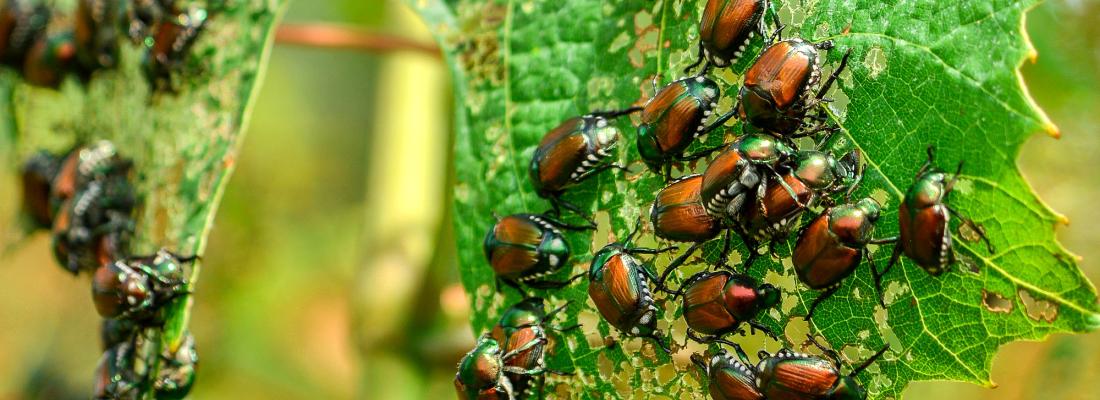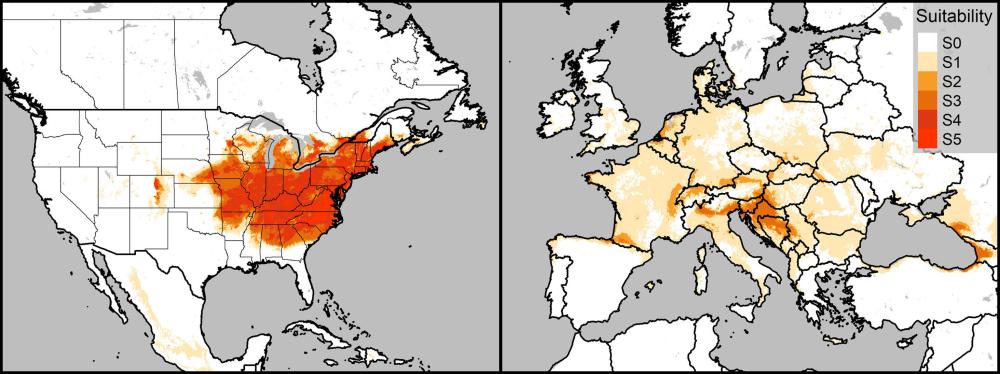Biodiversity Reading time 4 min
The Japanese beetle in Europe: modelling environmental suitability to customize pest monitoring strategies
Published on 04 December 2023

Invasion history
As its name suggests, the Japanese beetle (Popillia japonica) is native to Japan. A particularly polyphagous species, it was first detected in 1916 in the US, where it was presumably introduced by accident. Since that time, the beetle has colonized most of the East Coast. In the 1970s, the species was discovered in the Azores, Portugal, and has since become established on eight of the archipelago's nine islands. Observed in Italy in 2014, the beetle was immediately added to the European Union's list of priority quarantine pests. It has since steadily spread across the continent.
Creating value from data on beetle distributions and environmental suitability
The researchers utilized a species distribution model (SDM) that incorporated over 100 environmental factors of biological relevance for the beetle, including climatic conditions, habitat characteristics, land use, and anthropogenic factors. The model was trained using occurrence data from the beetle’s native and long-invaded ranges (Japan, North America, and the Azores), namely 48,000 georeferenced observations. Most (77%) came from citizen science platforms and from monitoring campaigns conducted with standardized protocols. All the data can be freely accessed at Recherche Data Gouv.
A well-calibrated and powerful predictive model
Performance metrics indicated that the SDM was well calibrated and yielded consistent, robust predictions, particularly when using observational data from the US. The latter proved decidedly helpful in model assessment because official monitoring campaigns were launched immediately after the beetle’s arrival. Thus, the US invasion has been characterized in detail, and variability in beetle population densities has been extensively documented. Thus, the SDM made it possible to predictively map where the beetle could become established in continental Europe based on environmental suitability.

Environmental suitability maps for North America and continental Europe. Suitability is expressed using six shades of orange, where darker shades indicate greater suitability.
Environmental suitability varies across continental Europe
Around 63% of continental Europe is unfavourable to the establishment of the Japanese beetle. Furthermore, the continent lacks the highly suitable environments seen in the US. That said, Central Europe does contain suitable regions, namely those stretching from the foothills of the Alps to the northern Balkans and the eastern shores of the Black Sea. Similar regions occur in countries such as France, Germany, Austria, Switzerland, Belgium, and the Netherlands. A major takeaway of the research is that the beetle currently occupies just 1% of areas favourable to its establishment. Consequently, this pest could continue to expand its invasive range, which is limited to Italy and Switzerland at present. Such would have significant environmental, social, and economic impacts, underscoring the need for effective monitoring efforts.
Limiting the current invasion
In areas where the beetle is already found, we must keep tabs on the invasion front and implement control measures to limit the species' spread. The modelling results showed that suitable environments occur at a distance from existing beetle populations. As a result, strategies should target transportation hubs, such as train stations, airports, and shipping warehouses. Additionally, it is important to raise awareness in the general public: it is easy for the beetle to hitchhike to new locations. In zones outside of the beetle’s invasive range, it is crucial to implement early detection and rapid response measures to control the beetle's spread. One recommendation is to launch informational campaigns across Europe, particularly in the areas at greater risk because of their higher suitability. These efforts could teach stakeholders and everyday citizens to identify the beetle and provide tools for reporting its presence. At INRAE's Institute for Genetics, Environment, and Plant Protection (IGEPP) and Research Unit for Biostatistics and Spatial Processes (BioSP), researchers are assessing the risk that the beetle will be accidentally transported, by airplane, train, or truck, from its current invasive range to other parts of continental Europe.
REFERENCES
- Borner L., Martinetti D., Poggi S. (2023). A new chapter of the Japanese beetle invasion saga: predicting suitability from long-invaded areas to inform surveillance strategies in Europe. Entomologia Generalis, 43, 951–960. https://doi.org/10.1127/entomologia/2023/2073
- Borner L., Martinetti D., Poggi S. (2022). « Data for “A new chapter of the Japanese beetle invasion saga: predicting suitability from long-infested areas to inform surveillance strategies in Europe” ». Recherche Data Gouv, V1, https://doi.org/10.57745/GM2YVL

This project has received funding from the European Union's Horizon 2020 Research and Innovation Programme (grant no. 861852).
